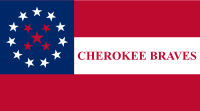1st Cherokee Mounted Rifles facts for kids
Quick facts for kids 1st Cherokee Mounted Rifles (Confederate) |
|
|---|---|

1st Cherokee Mounted Regiment flag
|
|
| Active | July, 1861-June 23, 1865 |
| Country | |
| Allegiance | |
| Branch | Cavalry |
| Size | Regiment |
| Garrison/HQ | Fort Wayne (Indian Territory) Cherokee Nation |
| Nickname(s) | Watie's Regiment |
| Equipment | Rifles & Carbines Mississippi Rifle Brown Bess Kentucky Rifle Sharps Rifle Spencer Rifle Gallager Carbine Maynard Carbine Springfield Rifle Sabers M1860 Light Cavalry Saber Pistols M1858 Remington M1860 Colt Army M1851 Colt Navy |
| Engagements | Battle of Pea Ridge Battle of Old Fort Wayne First Battle of Cabin Creek Second Battle of Cabin Creek |
| Commanders | |
| Notable commanders |
Brig. Gen. Stand Watie Col. John Drew Lt. Col. William P. Ross Maj. Thomas Pegg |
The 1st Cherokee Mounted Rifles was a group of soldiers from the Cherokee Nation who fought for the Confederate Army during the American Civil War. This group was a regiment, which is a military unit made of several smaller groups of soldiers. They fought mostly in the area known as Indian Territory, which is now part of Oklahoma.
The 1st Cherokee Mounted Rifles was formed by combining two earlier units: the First Regiment of Cherokee Mounted Rifles and the Second Regiment of Cherokee Mounted Rifles. The first leader of the combined group was Colonel John Drew. Later, the famous Cherokee leader Stand Watie took command.
Contents
How the Regiment Started
In July 1861, Confederate leaders asked Stand Watie to become a colonel in their army. They gave him permission to create a military group called the Cherokee Mounted Volunteers.
Later, in October 1861, the main leader of the Cherokee Nation, Chief John Ross, signed an agreement with the Confederacy. After this, he and the Cherokee Council (a governing body) created the First Regiment of Cherokee Mounted Rifles. This group was led by Colonel John Drew.
Most of the soldiers in Drew's group were full-blood Cherokees. They were very loyal to Chief John Ross. They didn't necessarily agree with the Confederacy's goals. At the same time, Watie's group became known as the Second Regiment of Cherokee Mounted Rifles. Watie's soldiers were mostly Cherokees of mixed heritage. Many of them owned enslaved people and supported the Confederate cause.
Problems Among the Soldiers
Drew's regiment was ordered to help stop a group of Creeks who supported the Union. These Creeks, led by their chief Opothleyahola, were trying to escape to Kansas.
Even though Drew's soldiers fought in battles like the Battle of Round Mountain, the Battle of Chusto-Talasah, and the Battle of Chustenahlah, they did not like fighting the Creeks. They felt the Creeks had not harmed the Cherokees. They had expected to fight against Union soldiers, not other Native American groups.
Changes to the Regiment
Some of Drew's soldiers left the group in late 1861. After the Battle of Old Fort Wayne in October 1862, most of the remaining soldiers from Drew's regiment, including Major Thomas Pegg, left to join the Union army.
The soldiers who remained from Drew's group were then combined with Watie's regiment. This new, combined group was renamed the First Regiment of Cherokee Mounted Rifles, and Stand Watie became its commander.
Stand Watie's Victories
During the Civil War, Watie's soldiers took part in 27 major battles and many smaller fights. While some were planned battles, they often used guerrilla tactics. This means they used surprise attacks and quick raids instead of large, open battles.
Watie's men launched raids from south of the Canadian River into Union-held Indian Territory, Kansas, and Missouri. These raids forced thousands of Union soldiers to stay in those areas to defend against them. Watie's Cherokee soldiers were not always well-equipped, often using captured weapons. However, they were very good at this type of fighting. In May 1864, Watie was promoted to brigadier general.
Some of Watie's most notable victories include:
- The Ambush of the steamboat J. R. Williams in June 1864.
- Capturing a Union wagon train at the Second Battle of Cabin Creek in September 1864.
Watie's troops also burned the home of Chief John Ross, called Rose Cottage, and the Cherokee Council House in October 1863. They were also involved in the Hay Camp Action in September 1864.
In February 1865, Watie was put in charge of the Indian Division of Indian Territory. However, he could not start any new attacks. He let most of his soldiers go home after the Confederate army started to fall apart in the spring of 1865.
After attending a meeting called the Camp Napoleon Council in May, Stand Watie officially surrendered on June 23, 1865. He was the last Confederate general to give up his weapons. After this, the regiment was officially ended.
Battle of Pea Ridge
This battle happened from March 6 to 8, 1862, in Benton County, Arkansas. The Union side won this battle.
Battle of Old Fort Wayne
This battle took place on October 22, 1862, at Fort Wayne in Indian Territory. The Union side was victorious.
Battle of Cabin Creek
This battle occurred on July 1 and 2, 1863, in Mayes County, Oklahoma. The Union side won this fight.
See also
 In Spanish: Primero de Rifles Montados Cheroquis para niños
In Spanish: Primero de Rifles Montados Cheroquis para niños

